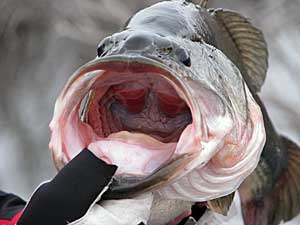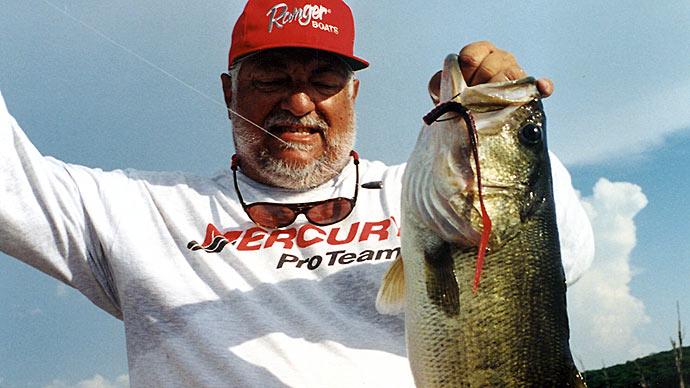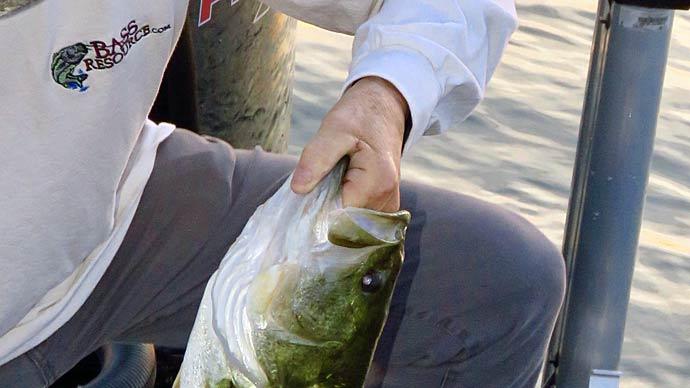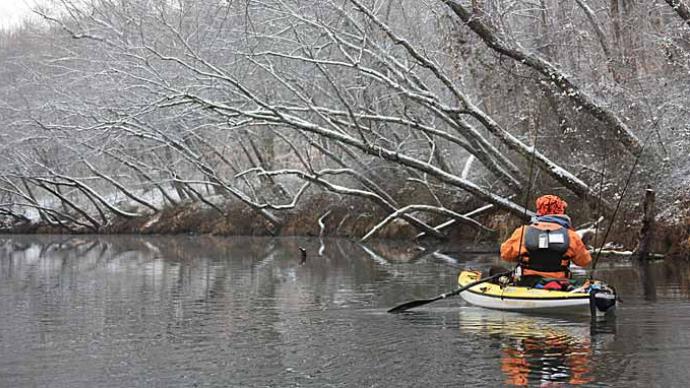
Big bass can be caught in Winter on all lakes, but you must expect fewer bites. Slow down your presentation. Remember, bass are cold-blooded and their metabolism slows down in cold conditions.
One of the best patterns in cold weather will be to fish the major creeks with timber or grass. Position your boat in the middle of the creek and work your lure along the edge of breaklines. Concentrate on major bends in creeks or where feeder creeks intersect. Key in on areas that have the most structure. Find several areas on your lake that have major brush piles and laydowns on creek bends and feeder creek intersections and work them thoroughly.
Without a doubt, the jig and pig is the number one producer of trophy bass. For your jig trailer, stay with pork trailer instead of plastic. Pork will produce more bites than a plastic trailer. During cold water conditions, black and blue, pumpkin, gourd green, and solid white are some of the best producers. Big deep-diving crankbaits in perch and chartreuse will also produce big fish. Don't forget your jigging spoons either.
When you locate bass on major creek bends, first work them with a jig and pig, next try your deep crankbaits, then move in and work your jigging spoon right over them. Contrary to popular belief, jigging spoons will produce trophy bass. They will also catch small bass, but trophy bass will also hammer a jigging spoon. Here on Lake Fork, many 10-pound plus bass are caught on jigging spoons. These baits will produce on other lakes as well. If you are after a trophy bass, you owe it to yourself to master the use of jigging spoons.
Now is a good time to plan a trip to one of the Texas power plant lakes. The water temperature on these lakes in January will be in the 70-degree plus range and most bass will be in the spawning or post spawn stage. Fish these lakes the same as you would cold-water lakes in springtime.
One pattern most fishermen overlook in late January and early February, on any lake, is shallow water. Look for areas protected from north winds near deep water. The back ends of major feeder creeks and protective coves are good places to start. Generally when you have two to three days of warmer weather, these areas will warm first. They might be just a few degrees warmer, but they draw some good bass to them.
Some of the best lures to throw are lipless crankbaits. Here on Lake Fork a 3/4-ounce red Rat-L-Trap is hot this time of the year. When you are fishing this pattern, cover a lot of water. When you connect, work the area thoroughly. Most lipless crankbaits out of the box do not have hooks that are suitable for big bass. Replace them with a good quality hook. Daiichi, Gamakatsu, and Mustad make some good, sharp and strong treble hooks. If you don't change out, you might get your heart broken.
I hope all of you catch your trophy bass this year. Make sure you practice catch and release so your children and grandchildren can have the same great bass fishing we now have. If you must put your fish in a livewell for a tournament weigh-in, use Catch & Release formula and handle all bass you plan on releasing with care. You will increase significantly the percentage that will survive.




